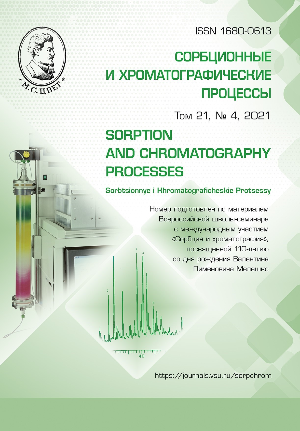The use of ion-exchange chromatography on DEAE-cellulose for the separation of isoenzymes of malate dehydrogenase from hepatocytes of normal rats and rats with alloxan-induced diabetes
Abstract
The aim of this work is to study the functional features of the multifunctional enzyme of the carbohydrate metabolism, malate dehydrogenase (MDH), in normal rats, rats with alloxan-induced diabetes, and in animals with a pathology which were orally given the alcohol extract of wormwood. It also investigated the isolation of the enzyme using ion exchange chromatography. The induction of experimental diabetes was carried out by a single intraperitoneal injection of 5% alloxan solution to Wistar white male laboratory rats (Rattus norvegicus). After the signs of diabetes appeared, all rats were divided into 3 groups: control animals (no injections of alloxan), the “diabetes” group (animals with signs of diabetes), and the “diabetes + wormwood extract (WE)” group (rats with increased glucose levels in blood that were given alcohol extract of wormwood instead of water).
The comparison of the specific activity of MDH from hepatocytes of livers of the rats from the control group subjected to alloxan diabetes and animals with a pathology which were given the wormwood extract, showed that under the conditions of induced diabetes, the rate of MDH functioning increases, while oral administration of the wormwood extract reduced the studied parameter to normal values. A purification of malate dehydrogenase was carried out to resolve the issue regarding the activation of certain metabolic processes associated with malate dehydrogenase activity in case of alloxan-induced diabetes.
The study showed that in comparison with the control animals, whose hepatocytes contained two MDH2 and MDH1 isoforms with a specific activity of 39.7 U/mg protein and 48.0 U/mg protein and the purification degree of 99.2 and 120.0, respectively, the animals with experimental diabetes also had an additional isoform of MDG3 with a specific activity of 38 U/mg protein and the degree of purification of 47.5. Two MDH isoforms with a specific activity of 72.08 and 60.5 U/mg protein and the degree of purification of 182.0 and 152.2, respectively, were characteristic of the group of rats that were orally administered a wormwood extract, which was consistent with the trends characteristic of malate dehydrogenase isoenzymes from the control group of animals. Thus, the use of 4-stage purification made it possible to obtain highly purified preparations of MDH isoforms from rat liver with alloxan-induced diabetes. The increase in activity and the appearance of a new isoform of MDH in the liver of diabetic rats confirm the possibility of the participation of the malate dehydrogenase enzyme system in the adaptive response of the organism under stress conditions. The results of the study indicate that a wormwood extract has a hypoglycemic effect, which is manifested in a noticeable decrease in the concentration of glucose in the blood of rats with alloxan-induced diabetes and in blocking the formation of an additional MDH isoform in animals with experimental diabetes.
Downloads
References
Selemenev V.F., Khohlov V.Ju., Bobreshova O.V., Aristov I.V. et al. Fiziko-himicheskie osnovy sorbcionnyh i mem-brannyh metodov vydeleniya i razdeleniya aminokislot M., Stelajt, 2002. 299 s.
Selivanova N.V., Maguljan M.B., Moiseenko A.V., Eprincev A.T., Sorbtsionnye i khromatograficheskie protsessy, 2020, Vol. 20, No 1, pp. 95-99.
Eprincev A.T., Popov V.N., Shevchenko M.Yu., Glioksilatnyj cikl: universal'nyj me-hanizm adaptacii?, M., IKC «Akademkniga», 2007, 228 p.
Grigor'eva E.A., Nejolova O.V., Sovremennye naukoemkie tehnologii, 2014, No 7-2, pp. 85-85.
Eprincev A.T., Popov V.N., Shevchenko M.Yu., Jekspressija i reguljacija fermentov glioksilatnogocikla, Voronezh, Central'no-Chernozemnoe knizhnoe izd-vo, 2005, 224 p.
Eprincev A.T., Falaleeva M.I., Klimova M.A., Kompanceva E.I., Biokhimija, 2006, Vol. 71, No 6, pp. 856860.
Yazdi H.B., Hojati V., Shiravi A., Hos-seinian S. et al., J Pharmacopuncture, 2019, Vol. 22, No 2, pp. 109-114.
Williams D.E., Reisfeld R.A., Annals of the New York Academy of Sciences, 1964, Vol. 121, No 2, pp. 372-381.
Glanc S., Mediko-biologicheskaya statis-tika, M., Praktika, 1999, 459 p.
Lenzen S., Diabetologia, 2008, Vol. 51, No 2, pp. 216-226.
Igamberdiev A.U., Logika organizacii zhivyh system, Voronezh, VGU, 1995, pp. 30-112.
Hochachka P., Somero Dzh., Biohimicheskaja adaptacija, M., Mir, 1988, pp. 311-337.
Popov V.N., Volvenkin S.V., Eprintsev A.T., Igamberdiev A.U., FEBS Lett., 1998, Vol. 440, No 1-2, pp. 55-58.
Al' Dajni Saba Hadi, Syromjatnikov M. Ju., Gati Mohannad Abdulrazzak Gati, Eprincev A.T., Vestnik VGU, Serija: Khimija. Biologija. Farmacija, 2012, No 1,pp. 176-180.
Tureck L., Kupov V., Uhlkov E., Mojto V., Physiol Res, 2014, 63(Suppl 4), рp. 585-591.







